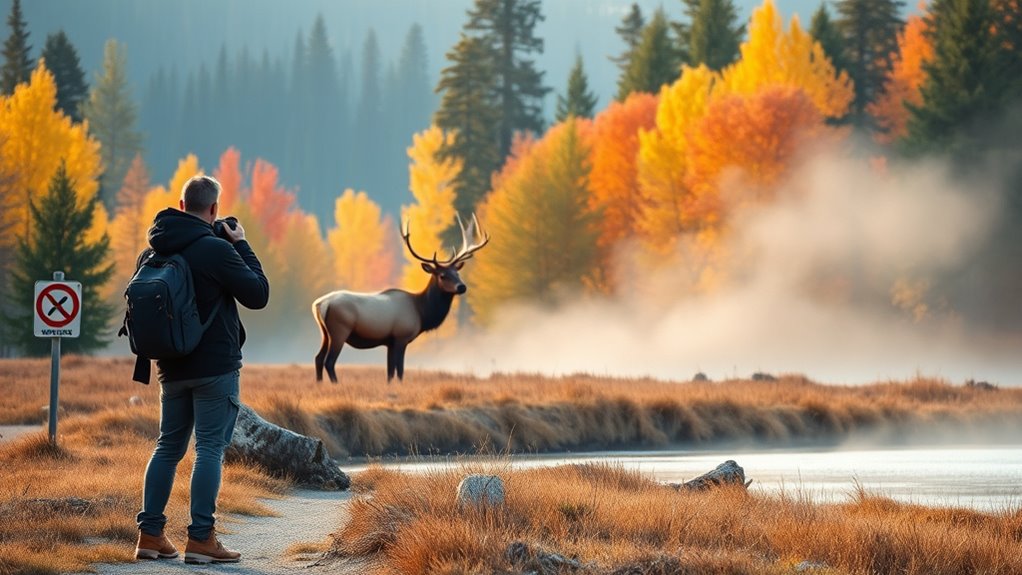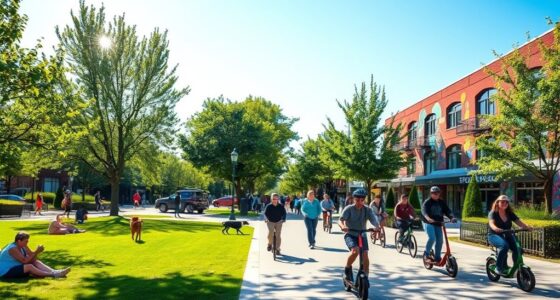When viewing wildlife in Banff National Park, keep your distance—stay at least 100 meters from bears and wolves, and 30 meters from elk and deer. Use binoculars or zoom lenses to observe without encroaching. Never feed animals, as it disrupts their natural behaviors and can lead to dangerous encounters. Always follow park regulations to protect both yourself and the wildlife. To learn more about responsible wildlife viewing practices, keep exploring our guidelines.
Key Takeaways
- Maintain a distance of at least 100 meters from bears and wolves, and 30 meters from elk and deer for safety.
- Use binoculars or zoom lenses to observe wildlife without getting too close, preserving their natural behaviors.
- Never feed wildlife, as it disrupts their foraging instincts and can lead to dangerous human encounters.
- Follow all park regulations and guidelines to ensure safety and contribute to wildlife conservation efforts.
- Respect wildlife by observing from a distance, allowing them to thrive and future visitors to enjoy their natural behaviors.

When you step into Banff National Park, you’re entering a breathtaking world where the majestic wildlife thrives. From the graceful elk wandering through the meadows to the elusive bears roaming the forests, every moment in this natural paradise can feel like an adventure. However, to fully appreciate the beauty of the park and its inhabitants, you must adhere to wildlife viewing etiquette.
One of the most vital aspects of this etiquette is understanding the importance of maintaining safe distances from wildlife. You might be tempted to get up close for that perfect photo, but remember, these animals are not domestic pets. Approaching too closely can stress them out and disturb their natural behaviors. A good rule of thumb is to stay at least 100 meters away from bears and wolves and 30 meters from elk and deer. Using binoculars or a zoom lens can help you enjoy the view without encroaching on their space.
Maintaining safe distances from wildlife is crucial; observe from afar to protect both their natural behaviors and your safety.
Feeding wildlife is another behavior that can have dire consequences. While it might seem harmless to toss a piece of bread to a curious squirrel or leave a few scraps for a deer, this practice can disrupt the animals’ natural foraging instincts. When wildlife becomes accustomed to human food, they may start seeking out people rather than foraging for their natural diet, which can lead to dangerous encounters. You wouldn’t want to unintentionally put yourself or the animals in harm’s way.
It’s essential to remember that wildlife in Banff National Park is wild. They’re not used to human interaction, and your presence can be intrusive. If you see an animal, enjoy the moment from a distance. You’ll often get the best experiences when you observe their natural behavior without interference. Furthermore, by respecting their space, you’re helping to make sure that future visitors can enjoy the same experiences.
Lastly, always follow any posted guidelines and regulations. Park rangers are there for a reason, and their rules are designed to protect both you and the wildlife. By practicing responsible viewing habits, you contribute to the preservation of this stunning ecosystem. Regularly observing wildlife from a distance helps ensure the safety of both visitors and animals. So, before you head out, keep these principles in mind. With a little respect and awareness, you’re not just a visitor; you’re a guardian of Banff’s incredible wildlife. Enjoy your adventure, but do so with care.
Frequently Asked Questions
What Is the Best Time of Year for Wildlife Viewing in Banff?
The best time for wildlife viewing in Banff is during spring and early fall. Spring brings seasonal migration, as animals return from their winter habitats, and you’ll see more activity as they search for food. Early fall is also great, as animals prepare for winter, showcasing their unique behaviors. Keep an eye out during dawn and dusk, when animal activity patterns peak, ensuring you catch the most breathtaking sights in the park.
Are There Specific Areas in Banff Known for Wildlife Sightings?
You might think all areas in Banff are the same for wildlife sightings, but some spots truly stand out. Head to the Bow Valley Parkway for stunning wildlife photography opportunities, especially during dawn or dusk. Don’t miss the bird watching hotspots near Lake Minnewanka; you’ll spot various species. Additionally, the Vermilion Lakes area is perfect for observing moose and elk. These locations enhance your chances of unforgettable wildlife encounters!
Can I Bring My Dog While Wildlife Viewing in Banff?
You can’t bring your dog while wildlife viewing in Banff, as it poses risks to both your pet and the wildlife. Leash laws are strictly enforced to safeguard animals and guarantee dog safety. Even on-leash, dogs can disturb wildlife, leading to dangerous situations. It’s best to leave your dog at home or in a safe area while you enjoy the stunning sights and sounds of nature without any distractions.
What Should I Do if I Encounter a Bear?
If you encounter a bear, stay calm and back away slowly. Did you know that nearly 90% of bear encounters can be resolved without conflict? Maintain a proper distance—at least 100 yards—between you and the bear. Make noise to alert it of your presence, and never run or approach it. Follow bear safety guidelines to guarantee both your safety and the bear’s well-being. Always respect their space and enjoy watching from afar!
Are There Any Fees for Entering Banff National Park?
Yes, there are park entrance fees for Banff National Park. You’ll need to pay these fees when you enter, which help maintain the park’s beauty and services. If you plan to engage in wildlife photography, make sure to follow the wildlife photography regulations to protect the animals and their habitats. It’s essential to respect these rules while enjoying the stunning scenery and unique wildlife the park offers.
Conclusion
In conclusion, respecting wildlife etiquette in Banff National Park isn’t just a suggestion—it’s essential. By keeping your distance and not feeding animals, you’re helping maintain their natural behaviors and safety. Remember, a single moment of carelessness can have consequences as dramatic as a bear in a tutu! So, be mindful, stay informed, and let’s ensure that future generations can marvel at the breathtaking beauty of Banff’s wildlife just like you do today.










